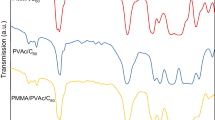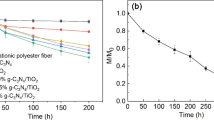Abstract
Polymers have become a major pollutant worldwide because their excessive use and poor disposal handling. Therefore, a system with selective solar concentration is proposed to solve this problem. This system is composed of a solar concentrator and a filter with upconversion nanoparticles made of rare earths. These materials can be obtained by the co-precipitation method. The materials are designed with a matrix of NaYF4 codoped by Yb3+ and Tm3+ so the upconversion process is carried out. This phenomenon helps to take advantage of the infrared radiation of the sun rays, converting it into UV radiation to improve the degradation efficiency in the solar concentrator system. The high density of the UV radiation concentrated on the polymer surface should promote a super accelerated degradation since the UV frequency is capable to break-down polymeric chains. It is expected that this strategy would be a sustainable option to reduce the impact of the polymeric waste.




Similar content being viewed by others
Data Availability
All data generated or analyzed during this study are included in this review.
References
Namsheer N, Sekhar C (2021) Conducting polymers: a comprehensive review on recent advances in synthesis, properties and applications. RSC Adv. https://doi.org/10.1039/D0RA07800J
Niyitanga E, Sarmad Q (2021) Plastic waste and its management strategies for environmental sustainability. C Stud Chem Environ Eng. https://doi.org/10.1016/j.cscee.2021.100142
Young R, Lovell P (2013) Introduction to polymers. CRC Press, Boca Raton
Chandrinos A (2021) A Review of Polymers and Plastic High Index Optical Materials. J Mater Sci Res Rev 7:1–14
Pellis A, Malinconico M (2021) Renewable polymers and plastics: Performance beyond the green. New Biotech. https://doi.org/10.1016/j.nbt.2020.10.003
Boucher J, Billard G (2019) The challenges of measuring plastic pollution. J F Actions 19:68–75
Stanton T, Kay P (2021) It’s the product not the polymer: Rethinking plastic pollution. WIREs Water. https://doi.org/10.1002/wat2.1490
Nanda S, Berruti F (2020) Municipal solid waste management and landfilling technologies: a review. Environ Chem Lett. https://doi.org/10.1007/s10311-020-01100-y
United States Environmental Protection Agency (2018) Advancing Sustainable Materials Management: Facts and Figures Report, Fact sheet, Pennsylvania. https://www.epa.gov/facts-and-figures-about-materials-waste-and-recycling/advancing-sustainable-materials-management. Accessed 01 Apr 2022
Statista Research Department (2022) Producción mundial de plástico 1950-2020, Hamburg. https://es.statista.com/estadisticas/636183/produccion-mundial-de-plastico/
De la Torre G (2019) Microplásticos en el medio marino: una problemática que abordar. Rev Cienc Tecnol 15:27–37
Schirinzi GF (2020) Chemical and ecotoxicological assessment of microplastics and emerging risks in the coastal environments. Ph D Thesis. Universitat de Barcelona, Barcelona
Lau W, Shiran Y (2020) Evaluating scenarios toward zero plastic pollution. Sci. https://doi.org/10.1126/science.aba9475
Vohlídal J (2021) Polymer degradation: a short review. Chem Teach International. https://doi.org/10.1515/cti-2020-0015
Schwarz A, Ligthart T (2021) Plastic recycling in a circular economy; determining environmental performance through an LCA matrix model approach. Waste Manag. https://doi.org/10.1016/j.wasman.2020.12.020
Bilokur M, Gentle A (2020) Spectrally Selective Solar Absorbers based on Ta:SiO2 Cermets for Next-Generation Concentrated Solar-Thermal Applications. Energy Technol. https://doi.org/10.1002/ente.202000125
Omazic A, Oreski G (2019) Relation between degradation of polymeric components in crystalline silicon PV module and climatic conditions: A literature review. Sol Energy Mater Sol Cell. https://doi.org/10.1016/j.solmat.2018.12.027
Dincer I, Zamfirescu C (2016) Sustainable Hydrogen Production. Elsevier
Caryl CR, Helmick WE (1960) U.S. Patent No. 2,945,417. Washington, DC: U.S. Patent and Trademark Office
Jorgensen GJ, Bingham C, Goggin R, Lewandowski AA, Netter JC (2000) U.S. Patent No. 6,073,500. Washington, DC: U.S. Patent and Trademark Office
Qin J, Jiang J (2021) Sunlight tracking and concentrating accelerated weathering test applied in weatherability evaluation and service life prediction of polymeric materials: A review. Polym Test. https://doi.org/10.1016/j.polymertesting.2020.106940
Wypycht G (2020) Handbook UV Degradation and Stabilization. Elsevier, Canada
Wang M (2011) Upconversion nanoparticles: synthesis, surface modification and biological applications. Nanotechnol Biol Med Nanomed. https://doi.org/10.1016/j.nano.2011.02.013
Chen B, Wang F (2020) Emerging Frontiers of Upconversion Nanoparticles. Trend Chem. https://doi.org/10.1016/j.trechm.2020.01.008
Zhixiong C, Feiming L (2019) Novel Nanomaterials for Biomedical. Elsevier, Environmental and Energy Applications
Naccache R, Yu Q (2015) The Fluoride Host: Nucleation, Growth, and Upconversion of Lanthanide-Doped Nanoparticles. Advanced Optical Mat. https://doi.org/10.1002/adom.201400628
Xiaohui Z (2019) Recent Progress of Rare-Earth Doped Upconversion Nanoparticles: Synthesis, Optimization, and Applications. Advanced Sci. https://doi.org/10.1002/advs.201901358
Jiao Y, Ling C (2020) Recent Progress of Rare-Earth Doped Upconversion Nanoparticles: Synthesis, Optimization, and Applications. Part Part Syst Charact. https://doi.org/10.1002/advs.201901358
Zhang ZJ (2009) Optical Properties and Spectroscopy of Nanomaterials. World Scientific, Santa Cruz
Xu R, Xu Y (2017) Modern Inorganic Synthetic Chemistry. Elsevier, Changchun
Yong X, Gan H (2020) Hydrothermal Synthesis of Nanomaterials. J Nanomat. https://doi.org/10.1155/2020/8917013
Heuer A, Neus F (2019) The Role of Ligands in the Chemical Synthesis and Applications of Inorganic Nanoparticles. Chem Rev. https://doi.org/10.1021/acs.chemrev.8b00733
Lu Y, Dekang X (2019) Regulation of morphologies and luminescence of β-NaGdF4:Ybc+, Er3+ upconversion nanoparticles by hydrothermal method and their dual-mode thermometric properties. Appl Surf Sci. https://doi.org/10.1016/j.apsusc.2018.09.209
Rafique R, Baek S (2018) Morphological evolution of upconversion nanoparticles and their biomedical signal generation. Sci Rep. https://doi.org/10.1038/s41598-018-35513-1
Atabaev T, Molkenova A (2019) Upconversion optical nanomaterials applied for photocatalysis and photovoltaics: Recent advances and perspectives. Front Mat Sci. https://doi.org/10.1007/s11706-019-0482-z
Quraishi S, Plappert S (2019) Chemical versus physical grafting of photoluminescent amino-functional carbon dots onto transparent nematic nanocellulose gels and aerogels. Cellul. https://doi.org/10.1007/s10570-019-02619-2
Xiao K, Xu Y, Cao X, Xu H, Li Y (2022) Chaper 18-Advanced characterization of membrane Surface fouling. 60 Years of the Loeb-Sourirajan Membr. https://doi.org/10.1016/B978-0-323-89977-2.00022-1
Verma N, Kaur J, Dubey V, Dubey N, Ram T (2023) Luminescence properties of Y2SiO5 phosphors: A review. Inorg Chem Commun. https://doi.org/10.1016/j.inoche.2022.110234
Pennycook SJ (2005) Transmission Electron Microscopy. Encycl of Condensed Matter Phys. https://doi.org/10.1016/B0-12-369401-9/00582-9
Jia T, Chen G (2022) Lanthanide nanoparticles for near-infrared II theranostics. Coordination Chem Rev. https://doi.org/10.1016/j.ccr.2022.214724
Kumar D, Verma K (2018) Recent advances in enhanced luminescence upconversion of lanthanide-doped NaYF4 phosphors. Condens Matter, Phys B. https://doi.org/10.1016/j.physb.2017.08.003
Velazquez J, Balda R, Fernandez J (2021) Structural and optical properties in Tm3+/Tm3+–Yb3+ doped NaLuF4 glass-ceramics. J Appl Glass Sci. https://doi.org/10.1111/ijag.16322
Wang W, Huang C, Zhang C (2018) Controlled synthesis of upconverting nanoparticles/ZnxCd1-xS yolk-shell nanoparticles for efficient photocatalysis driven by NIR light. Environ, Appl Catal B. https://doi.org/10.1016/j.apcatb.2017.11.037
Wang Z, Meijerink A (2018) Concentration Quenching in Upconversion Nanocrystals. J Phys Chem. https://doi.org/10.1021/acs.jpcc.8b09371
Ugemuge N, Parauha Y (2021) Energy Materials. Elsevier, Nagpur
Otanicar T, DeJarnette D (2016) Filtering light with nanoparticles: a review of optically selective particles and applications. Adv Opt Photonics. https://doi.org/10.1364/AOP.8.000541
Ancona M, Antonucci V (2019) Thermal integration of a high-temperature co-electrolyzer and experimental methanator for Power-to-Gas energy storage system. Energy Convers Manag. https://doi.org/10.1016/j.enconman.2019.02.057
Fossa M, Boccalatte A (2021) Solar Fresnel modelling, geometry enhancement and 3D ray tracing analysis devoted to different energy efficiency definitions and applied to a real facility. Sol Energy. https://doi.org/10.1016/j.solener.2020.12.047
Lai W, Rogach A (2017) Molecular design of upconversion nanoparticles for gene delivery. Chem Sci. https://doi.org/10.1039/C7SC02956J
Cho S, Uddin M (2017) Emerging Nanotechnologies in Rechargeable Energy Storage Systems. Elsevier, Miñano
Ogarev V, Rudoi V (2018) Gold Nanoparticles: Synthesis, Optical Properties, and Application. Appl Res, Inorg Mat. https://doi.org/10.1134/S2075113318010197
Jin D, Xi P (2018) Nanoparticles for super-resolution microscopy and single-molecule tracking. Nat Method. https://doi.org/10.1038/s41592-018-0012-4
Qian H, Guo H (2009) Mesoporous-Silica-Coated Up-Conversion Fluorescent Nanoparticles for Photodynamic Therapy. Small. https://doi.org/10.1002/smll.200900692
Zhang J, Mi C (2012) Synthesis of NaYF4:Yb/Er/Gd up-conversion luminescent nanoparticles and luminescence resonance energy transfer-based protein detection. Anal Biochem. https://doi.org/10.1016/j.ab.2011.11.008
Selvin P, Rana T (1994) Luminescence Resonance Energy Transfer. J Am Chem Soc. https://doi.org/10.1021/ja00092a088
Wu X, Zhang K (2017) Facile preparation of BiOX (X = Cl, Br, I) nanoparticles and up-conversion phosphors/BiOBr composites for efficient degradation of NO gas: Oxygen vacancy effect and near infrared light responsive mechanism. Chem Eng J. https://doi.org/10.1016/j.cej.2017.05.044
González E, Sánchez M (2014) Desarrollo de un concentrador solar para la degradación acelerada de polímeros de desecho. Ideas en Ciencia 41:47–58
Rabek JF (1995) Polymer Photodegradation. Mechanisms and Experimental Methods. Chaptman & Hall, Chapter 2, 26. https://doi.org/10.1007/978-94-011-1274-1https://doi.org/10.1007/978-94-011-1274-1
Rossi T, Escobedo J (2018) Global, diffuse and direct solar radiation of the infrared spectrum in Botucatu / SP / Brazil. Renew Sustain Energy Rev. https://doi.org/10.1016/j.rser.2017.09.030
Cen H, He Y (2007) Theory and application of near infrared reflectance spectroscopy in determination of food quality. Trends Food Sci Technol. https://doi.org/10.1016/j.tifs.2006.09.003
Wu S, Lv J (2017) Photocatalytic degradation of microcystin-LR with a nanostructured photocatalyst based on upconversion nanoparticles@TiO2 composite under simulated solar lights. Sci Rep. https://doi.org/10.1038/s41598-017-14746-6
Author information
Authors and Affiliations
Corresponding authors
Ethics declarations
Conflicts of interests
There is no conflict of interest to declare.
Additional information
Publisher's Note
Springer Nature remains neutral with regard to jurisdictional claims in published maps and institutional affiliations.
Rights and permissions
Springer Nature or its licensor (e.g. a society or other partner) holds exclusive rights to this article under a publishing agreement with the author(s) or other rightsholder(s); author self-archiving of the accepted manuscript version of this article is solely governed by the terms of such publishing agreement and applicable law.
About this article
Cite this article
Pineda-Sánchez, R., Martinez-Calvo, E.A., Sánchez-Pozos, M. et al. Review on polymer degradation by selective solar concentration using up-conversion nanoparticles. J Polym Res 30, 296 (2023). https://doi.org/10.1007/s10965-023-03689-4
Received:
Accepted:
Published:
DOI: https://doi.org/10.1007/s10965-023-03689-4




